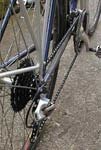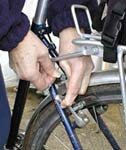|
Part 1 - Removing the rear wheel. Can be difficult, can be real easy. We show you the easy way.
|
We were going to call this identifying the problem and show you a flat tyre, but we feel everyone would know what a flat tyre looks like.
Resist the temptation to ride, even if people do tell you "it's only flat at the bottom".
Riding will damage your tyre and possibly your rim. |
.
We said we'd show you the easy way, well here goes. The first thig you should do is transfer the chain onto the outer rings at both the front and rear of the bike. This makes it much easier to get the wheel on and off the bike. Click on the photo for a larger picture to see exactly what we mean.
|

Loosen the brake cables before attempting to remove the wheel. Whilst you will experience little difficulty with a flat tyre, a fully inflated tyre will cause you a few problems. Practise this at home and ensure you know how to do it.
|